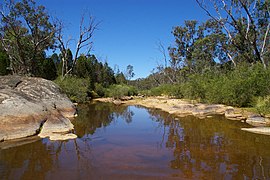Chiltern-Mount Pilot National Park
|
Chiltern–Mt Pilot National Park Victoria |
|
|---|---|
|
IUCN category II (national park)
|
|

Reedy Creek at Gladstone Track
|
|
| Nearest town or city | Chiltern |
| Coordinates | 36°07′59″S 146°36′04″E / 36.13306°S 146.60111°ECoordinates: 36°07′59″S 146°36′04″E / 36.13306°S 146.60111°E |
| Established | 30 October 2002 |
| Area | 215.6 km2 (83.2 sq mi) |
| Managing authorities | Parks Victoria |
| Website | Chiltern–Mt Pilot National Park |
| See also | Protected areas of Victoria |
The Chiltern-Mt Pilot National Park is a national park that is located in the Hume region of Victoria, Australia. The 21,650-hectare (53,500-acre) national park is situated approximately 275 kilometres (171 mi) northeast of Melbourne, and extends west from Beechworth across the Hume Freeway and the Albury-Melbourne railway line to the west of Chiltern.
The park was established under the National Parks (Box–Ironbark and Other Parks) Act, 2002 (Vic) to protect a diverse range of threatened species and ecosystems. The distinctive features of the park include the Woolshed Falls, picturesque Mt Pilot summit, culturally significant Aboriginal rock art at Yeddonba and historical relics of the goldmining era scattered throughout. The park is used for a number of recreational activities including bushwalking, hiking, trail riding, rock climbing, picnicking, camping, bird watching and prospecting.
At the time of European settlement, box-ironbark forests covered approximately 3,000,000 hectares (7,400,000 acres) or 13% of Victoria. As a result of settlement, nearly 80% of these forests were cleared and the remaining areas were badly degraded by grazing. The forests of the Chiltern-Mt Pilot National Park are living testament to these claims with some of its natural systems deteriorated as a result of grazing, clearing, logging and mining.
When gold was discovered in the area during the mid 1800s, extensive alluvial and reef mining, quartz mining and gravel quarrying began. Fossicking, prospecting and gem hunting are still permitted within the park today. Evidence of these activities including disturbed ground, mullock heaps, dams and old mineshafts may be found scattered throughout the park.
Pastoralists driving cattle through Chiltern, known at the time as Black Dog Creek, discovered the forests of box and ironbark during the 1930s. The species were renowned for their strong durable timber and soon felled for fencing, construction and firewood. In fact, firewood collection continued until 2002 when the National Park was formed. A landscape that was originally dominated by large, mature trees and grassy forest floors quickly deteriorated into closely packed stands of multi-stemmed coppice regrowth.
...
Wikipedia

